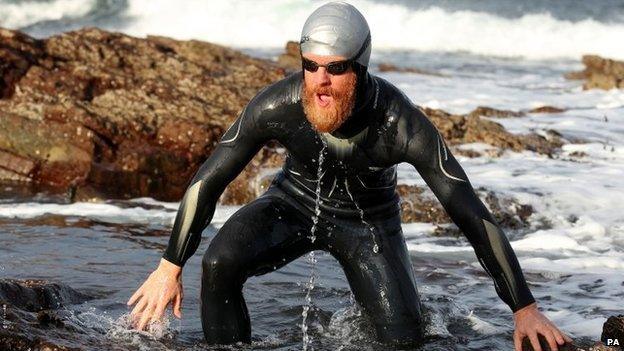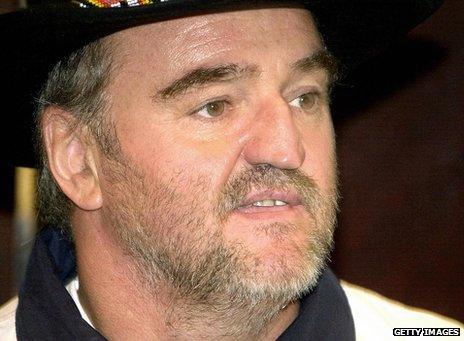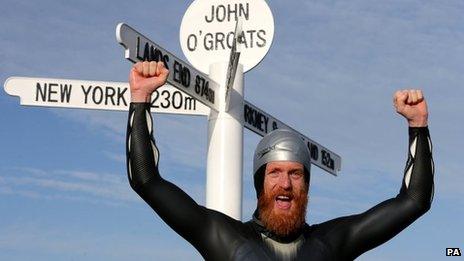Sean Conway: How hard is it to swim the length of Britain?
- Published

Sean Conway this week finished his four-and-a-half month long swim from Land's End to John O'Groats - via Ireland. But what makes it such a tough challenge?
He was the first: People have swum from Cuba to the US, across the Bering Strait, and between New Zealand's north and south island. But no-one had swum from Land's End to John O'Groats before. "So I had no-one to ask for advice," says Conway.
The physical toll: He was not a serious swimmer before the trip. His technique unravelled as tiredness set in. "The first hour of the day would be great, my technique would be good. After an hour and a half I'd start dropping the shoulders and the elbows, then it's a downhill spiral, feeling weak and cold." He was swimming about 2,500 strokes an hour. Over the course of the whole trip he swam about three million strokes. The neck and shoulders get chafing. He lost a lot of weight. He was nearly 11 stone (70 kg) when he set off and ended up under 10 (63.5 kg) . "I didn't have enough body fat. I was burning more calories than I could eat," he says.
Icy water: The cold was always there. "I could barely talk when I got out," he says. Not only was it uncomfortable, it sapped the strength. And there was no shower on the boat where he could warm up. The water averaged 14 or 15C for most of the swim. There were two extra cold "patches" - the swim across from Northern Ireland and the waters around Skye were both 12 Celsius, he says. After the first two weeks, he found his body adjusting to the cold. But unfortunately this was offset by his weight loss. His wetsuit became baggier, meaning it let more water in and allowed his body heat to escape. His jaw was so cold in the water that feeds had to be via pureed food. "Sean had to control his core body temperature within fine limits to swim, digest food and survive," says Mark Kleanthous, who coached Conway before the swim. "Water is 25 times more conductive than air, resulting in a great loss of body temperature. When muscle temperature drops by just one degree performance dips by as much as 3% making it harder to swim."
The time: Swimming 10 miles a day is not an "enormous" amount, says Andrew Lane, professor of sports psychology at the University of Wolverhampton. But to do this for four-and-a-half months is a huge challenge. When Conway set off on 30 June, he expected the swim to take two months. A nice summer adventure. In the end it took more than twice that. It would have been easy to think after two months that he'd done his bit, says Lane. He could have found plausible excuses and felt satisfied with his efforts. But that's not how endurance athletes can think. "You have to be born a little different maybe," says Martin Strel, the Slovenian long distance swimmer who in 2001 swam for 84 hours non-stop along the Danube - a world record. "Don't change your mind. You have to say this before the start. You don't change the schedule halfway," Strel says. By the end Conway was worried the weather would prevent them completing it before Christmas. The support crew had already given up far more time than planned. In desperate moments he thought about letting the crew go home and pressing on without the boat. It wasn't realistic, he admits. Luckily the weather cleared enough for them to be able to finish.

Martin Strel is a world record holder
Wildlife: He swam through shoals of jelly fish. After being stung on the face, he grew a beard to protect himself. Long distance swimmers have to overcome fears of "what lurks in the deep", says Lane.
Salt water: By the end he was extremely sensitive to swallowing sea water. "My gag reflex from salt water would make me throw up. In the last three weeks just swallowing half a teaspoon full would make me vomit."
The tide: The sea's pull went north to south and vice versa in roughly six-hour periods, meaning he had to try and cover as much distance as possible when the tide was with him. And then sit it out when it was against him. "So I had six hours to do my best."

Conway celebrates his achievement
Logistics: He slept on a 55-year-old wooden support boat. "The biggest dreams I had were about the boat sinking." It took four-six hours to traverse between the start and end of each day's swim and a suitable mooring. Finding places to anchor was far more difficult than anticipated, he says.
The loneliness: Head down in the water for hours on end, with only darkness below, alone with one's thoughts is not easy. Fewer people have successfully swum the English Channel than climbed Everest, says Kleanthous. The relatively high failure rate is partly due to the mental discipline required. Conway says he is a stubborn character. He broke the day up into 90 minute segments rather than think about how far was left. A crucial factor was the "ability to switch off", he says. "You stop thinking about negative stuff and have fun." Music helped. There was one dubstep song by Australian band Knife Party that helped. "I shouldn't say which one as the lyrics are not very nice."
Follow @BBCNewsMagazine, external on Twitter and on Facebook, external